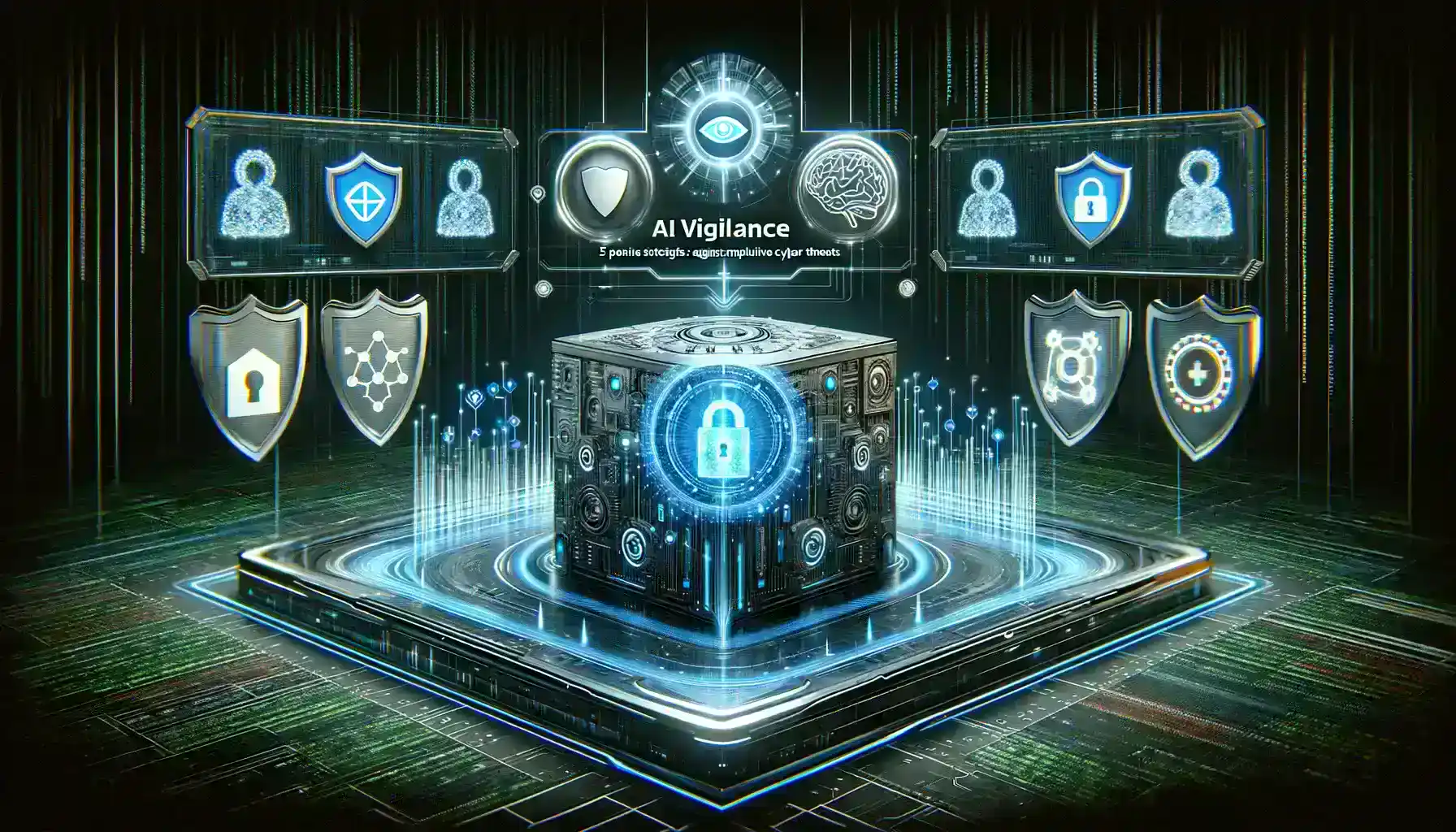Table of Contents
In the dynamic realm of artificial intelligence (AI), the surge in cyber threats aimed at compromising AI systems has emerged as a significant worry. With organizations increasingly dependent on AI for critical decision-making processes, safeguarding the integrity and security of these systems has become an imperative.
The term “AI Vigilance” encapsulates a proactive stance in fortifying AI against potential manipulative cyber threats. This article delves into the multifaceted concept of AI Vigilance, elucidating the need for comprehensive protective measures. It aims to dissect the evolving threat landscape surrounding AI and offers a strategic approach to mitigate risks.
As AI permeates various sectors, from healthcare to finance, the potential ramifications of compromised systems underscore the urgency for robust defenses. Against this backdrop, the article unfolds five positive strategies designed to counteract manipulative cyber threats.
From robust encryption protocols and continuous monitoring to user education and collaboration, each strategy contributes to an overarching framework of AI Vigilance. By implementing these proactive measures, organizations can not only enhance the resilience of their AI systems but also foster a secure and trustworthy foundation for the future integration of AI technologies.
Understanding AI Vigilance

AI Vigilance is a proactive defense mechanism aimed at securing AI systems from malevolent manipulations. This strategic approach entails a comprehensive framework for recognizing, evaluating, and alleviating potential threats that pose risks to the functionality and reliability of AI technologies.
In essence, it is a preemptive stance against the evolving landscape of cyber threats targeting artificial intelligence. The core pillars of AI Vigilance involve continuous monitoring, robust encryption protocols, and the implementation of advanced anomaly detection mechanisms.
By adopting these measures, organizations can establish a fortified defense, ensuring the confidentiality, integrity, and seamless operation of AI systems. Regular security audits and updates further contribute to the resilience of AI infrastructure, identifying vulnerabilities and promptly addressing them to stay ahead of potential threats.
Ultimately, AI Vigilance is a multifaceted strategy that recognizes the dynamic nature of cyber threats and proactively adapts to safeguard the integrity and functionality of AI technologies in an ever-evolving digital environment.
Robust Encryption Protocols
Implementing robust encryption protocols is a cornerstone in fortifying AI Vigilance against cyber threats. This strategy involves safeguarding data at every stage of its lifecycle, encompassing storage, transmission, and processing. Encryption serves as a protective shield, rendering data indecipherable to unauthorized entities and thwarting potential manipulations by cyber criminals.
By encrypting information, organizations ensure the confidentiality and integrity of sensitive data, thereby mitigating the risk of unauthorized access or tampering. Throughout storage, robust encryption transforms data into an unreadable format, ensuring that even if an unauthorized party gains access, the information remains unintelligible.
During transmission, encrypted data is securely transferred, reducing the likelihood of interception or eavesdropping by malicious actors. Additionally, encryption during processing safeguards data integrity, preventing unauthorized alterations or manipulations.
This comprehensive approach to encryption not only bolsters the security of AI systems but also adds a layer of resilience, making it considerably more challenging for cybercriminals to compromise the underlying infrastructure. As a fundamental element of AI Vigilance, robust encryption contributes significantly to the overall protection and trustworthiness of AI technologies in today’s digital landscape.
Continuous Monitoring and Anomaly Detection
Continuous monitoring is a cornerstone of AI Vigilance, focusing on the timely detection of unusual or anomalous behavior within AI systems. This involves the integration of advanced anomaly detection mechanisms that operate in real-time, providing organizations with the ability to identify potential threats swiftly.
Establishing a baseline for normal AI system behavior is pivotal in this process. By comprehensively understanding how the AI system typically operates under normal circumstances, any deviations from this baseline can be promptly recognized. The system can then trigger alerts or notifications, prompting immediate investigation and analysis.
This proactive approach allows organizations to stay one step ahead of potential threats, enabling the implementation of preventive measures before significant harm occurs. Continuous monitoring not only safeguards the integrity of AI systems but also ensures a dynamic and adaptive defense mechanism that evolves alongside emerging cyber threats in the ever-changing landscape of AI security.
Regular Security Audits and Updates
To uphold AI Vigilance, organizations must prioritize regular security audits and updates as integral components of their cybersecurity strategy. Conducting meticulous assessments of AI systems is imperative for pinpointing potential vulnerabilities susceptible to exploitation by cyber threats.
This proactive approach allows for the identification and remediation of weaknesses before they can be leveraged to compromise the integrity of AI infrastructure. Equally important is staying current with the latest security developments; this knowledge is a cornerstone in anticipating and mitigating emerging cyber threats effectively.
Swiftly applying software updates, patches, and security protocols is paramount to ensuring that the AI ecosystem remains resilient and adaptive in the face of evolving risks.
By fostering a continuous cycle of assessment, learning, and improvement, organizations can fortify their AI systems against potential vulnerabilities, thereby enhancing overall cybersecurity and instilling confidence in the reliability of AI-driven decision-making processes.
User Education and Training
Human factors are pivotal in ensuring effective AI Vigilance. Educating and training individuals within an organization about the potential risks tied to AI systems is paramount. Establishing a cybersecurity-aware culture is key, turning employees into a critical line of defense against social engineering attacks and inadvertent actions that might jeopardize AI security.
Regular training sessions are instrumental in empowering individuals, equipping them with the knowledge to recognize and report suspicious activities promptly. This proactive stance enhances the overall resilience of the AI ecosystem, creating a workforce that is not only proficient in utilizing AI but also vigilant in safeguarding it.
In a landscape where cyber threats constantly evolve, the human element emerges as a dynamic and adaptive force that complements technological safeguards. By fostering a sense of responsibility and awareness, organizations can harness the collective power of their workforce to fortify AI systems against potential risks and contribute to a robust cybersecurity posture.
Collaboration and Information Sharing

AI Vigilance transcends individual organizational boundaries, necessitating a collaborative industry-wide effort. Recognizing the interconnected nature of the digital landscape, fostering collaboration and information sharing becomes imperative. By establishing a unified front against cyber threats, organizations can collectively strengthen their defenses and respond more effectively to evolving challenges.
Encouraging a culture of collaboration involves the exchange of insights into emerging threats and the dissemination of effective mitigation strategies. This shared knowledge creates a symbiotic relationship where the collective intelligence of the industry becomes a potent weapon against malicious actors.
A community-driven approach to AI security not only enhances the resilience of individual organizations but also benefits the entire ecosystem. In this interconnected web of technology, a threat to one organization can potentially reverberate across the industry. Therefore, the collective responsibility to fortify AI systems against manipulative cyber threats extends beyond competitive interests.
It aligns with the common goal of creating a secure digital environment that safeguards the integrity of AI technologies and upholds the trust of users worldwide. Through collaboration and information sharing, the industry can proactively address challenges, fostering a stronger, more resilient defense against the ever-evolving landscape of cyber threats.
Examples
WhatsApp secures user communications through end-to-end encryption, thwarting unauthorized access to messages. This robust encryption is a pivotal defense against cyber threats, ensuring the privacy and trust of billions in their AI-powered messaging interactions.
CapitalOne leverages AI for fraud detection and prevention. Anomaly detection algorithms identify unusual patterns in financial transactions. Deviations trigger alerts, enabling CapitalOne to investigate and mitigate potential fraud, showcasing real-time AI Vigilance in safeguarding financial systems.
Google’s Phishing Quiz is a proactive user education initiative that empowers individuals to recognize and thwart phishing attacks. Enhancing awareness and resilience against social engineering, contributes to overall AI Vigilance, addressing the crucial human factor in cybersecurity and protecting AI systems from manipulation.
Conclusion

In the contemporary landscape, where the influence of AI technologies is becoming more pronounced in critical decision-making, the imperative of AI Vigilance cannot be overstated. Safeguarding the trust and reliability of these systems is paramount to ensuring their efficacy and ethical use.
Robust encryption emerges as a foundational pillar in this defense, creating an impervious shield around sensitive data as it traverses the various stages of AI operations. Continuous monitoring, an integral facet of AI Vigilance, acts as a vigilant guardian, promptly identifying and addressing any aberrations in the normal behavior of AI systems.
Regular security audits serve as a proactive measure, systematically assessing vulnerabilities and fortifying the system against potential threats. User education emerges as a linchpin in this defense strategy, empowering individuals within organizations to recognize and respond to potential risks. By fostering a culture of cybersecurity awareness, employees become active contributors to the resilience of AI ecosystems.
Furthermore, the collaborative aspect of AI Vigilance cannot be overlooked. Fostering collaboration and information sharing among organizations forms a united front against manipulative cyber threats. Embracing these positive strategies not only bolsters the security posture of AI systems but also collectively contributes to creating a digital landscape that is safer, more secure, and resilient against the ever-evolving challenges posed by malicious actors.